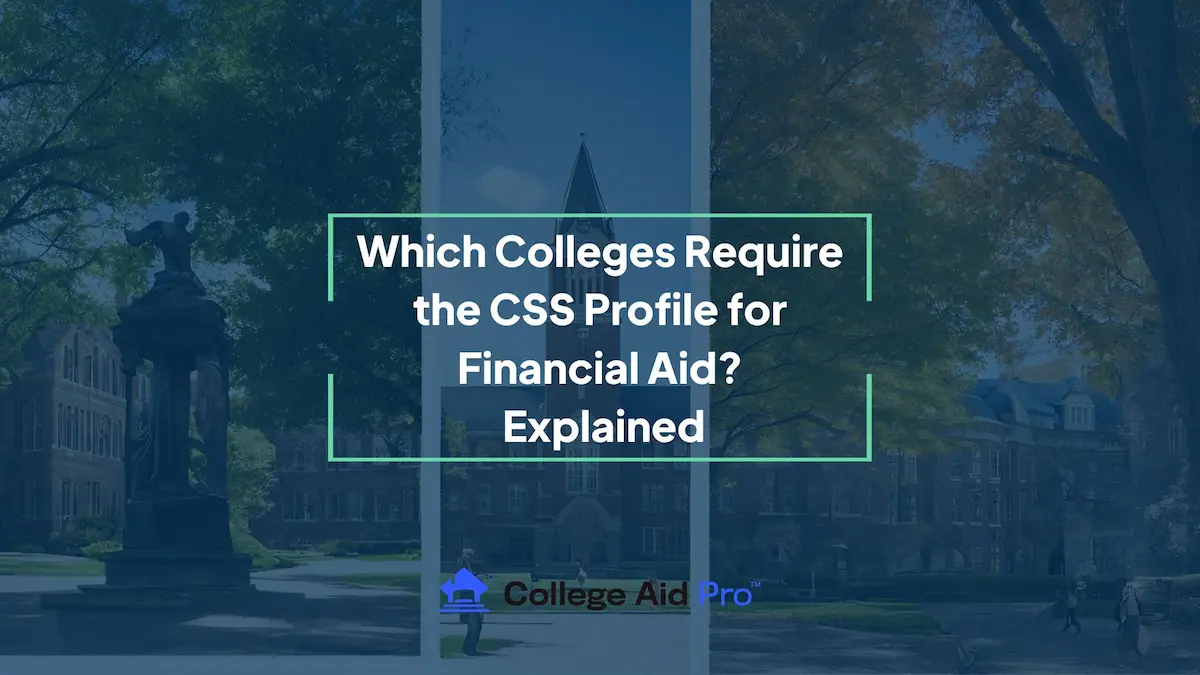What Colleges Require the CSS Profile for Financial Aid?
When it comes to applying for financial aid for college, most students and parents are familiar with the Free Application for Federal Student Aid (FAFSA). However, there’s another crucial financial aid form that some colleges and universities require: the CSS Profile. In this comprehensive guide, we’ll explore what the CSS Profile is, why some colleges require it, and most importantly, provide a list of colleges and universities that commonly require the CSS Profile.
Understanding the CSS Profile

The CSS Profile, or College Scholarship Service Profile, is a financial aid application created and maintained by the College Board. While the FAFSA is required for federal financial aid, such as Pell Grants and federal student loans, the CSS Profile is used by many private colleges and universities, as well as some public institutions, to determine eligibility for their institutional aid programs.
The CSS Profile goes beyond the FAFSA in its depth of information collection. It delves into a student’s and their family’s finances in great detail, providing colleges with a comprehensive view of their financial situation. This allows institutions to make more informed decisions about distributing their own financial aid resources.
Why Do Some Colleges Require the CSS Profile?
Colleges and universities that require the CSS Profile do so for several reasons:
- More Detailed Financial Information: The CSS Profile collects a broader range of financial information compared to the FAFSA. This enables colleges to gain a comprehensive understanding of a student’s financial situation, which is particularly important for need-based aid programs.
- Institutional Aid Allocation: Many colleges use the CSS Profile to allocate their own need-based scholarships, grants, and other forms of financial aid. By requiring the CSS Profile, they can ensure that their institutional aid goes to the students who need it most.
- Tailored Aid Packages: Requiring the CSS Profile allows colleges to tailor financial aid packages that consider both federal and state aid, as well as their own institutional aid programs. This helps institutions attract a diverse student body and meet their specific financial needs.
- Merit-Based Aid: Some colleges use the CSS Profile to determine eligibility for merit-based scholarships. These scholarships are often awarded based on academic achievements, extracurricular activities, and other non-financial factors.
- Consistency: Requiring the CSS Profile provides colleges with a standardized method of assessing financial need. This promotes fairness and consistency in the financial aid allocation process.
Key Differences Between the CSS Profile and FAFSA

While both the CSS Profile and FAFSA are tools for assessing financial need, they differ in several key ways:
- Purpose: The primary distinction lies in their purpose. The FAFSA is primarily used to determine eligibility for federal and state financial aid programs, whereas the CSS Profile is used by colleges and universities to award their own institutional aid.
- Timing: The FAFSA can be submitted as early as October 1st for the following academic year, while the CSS Profile has its own deadlines, which can vary by institution. Some colleges require the CSS Profile to be submitted as early as November 1st, so it’s essential to check each college’s specific deadlines.
- Required Information: The CSS Profile collects more detailed financial information, including home equity and non-custodial parent information, which is not required on the FAFSA. Additionally, the CSS Profile may ask for information from the previous year’s tax returns, while the FAFSA uses prior-prior year tax information.
- Dependency Status: The FAFSA uses specific criteria to determine a student’s dependency status, which can impact the financial information required. The CSS Profile may ask for more information from non-custodial parents in certain cases.
- Cost: Unlike the FAFSA, which is free to complete, the CSS Profile comes with an application fee. This fee covers the initial application and the submission of the report to one college or program. Additional reports to other colleges come with extra fees. However, fee waivers are available for eligible students.
- School List: On the FAFSA, you can list up to 20 colleges to receive your information without incurring additional fees. With the CSS Profile, you must pay an additional fee for each college or program you send it to.
Colleges That Commonly Require the CSS Profile

Now, let’s get to the core of our topic: which colleges and universities typically require the CSS Profile for financial aid applications? It’s important to note that the list of colleges that require the CSS Profile can change from year to year, so always check each school’s financial aid website for the most up-to-date information. However, there are certain categories of institutions that are more likely to require the CSS Profile:
1. Private Colleges and Universities
Private institutions often use the CSS Profile to assess financial need and allocate their own need-based aid. These schools include prestigious Ivy League universities, liberal arts colleges, and numerous other private institutions across the United States. Some well-known examples include Harvard University, Stanford University, and Yale University.
2. Highly Selective Colleges and Universities
Highly selective institutions, which often have rigorous admissions standards, are more likely to require the CSS Profile. These schools tend to offer generous financial aid programs to ensure that admitted students can attend regardless of their financial circumstances. Notable examples include Princeton University, Massachusetts Institute of Technology (MIT), and California Institute of Technology (Caltech).
3. Out-of-State Public Universities
Some out-of-state public universities may require the CSS Profile for non-resident students seeking financial aid. This is especially common when these institutions offer competitive merit-based scholarships to attract top talent from around the country. For instance, the University of Michigan and the University of Virginia are known to require the CSS Profile for certain aid programs.
4. Specialized Programs
Colleges and universities with specialized programs, such as conservatories of music, art schools, and specialized professional programs, may require the CSS Profile to determine eligibility for talent-based or program-specific scholarships. Examples include the Juilliard School and the Berklee College of Music.
5. Additional Scholarship Programs
Some institutions, in addition to federal and institutional aid, offer a variety of scholarship programs based on factors such as leadership, community service, or specific academic interests. These schools often use the CSS Profile to assess eligibility for these additional scholarship programs. Washington University in St. Louis and Boston University are known to use the CSS Profile for such purposes.
Here is a complete list of colleges and universities that require the CSS Profile:
| Adrian College, MI | Alabama A&M University | American University | Amherst College |
| Arizona State University | Arkansas State University | Babson College | Bard College |
| Bard College at Simons Rock | Barnard College | Bates College | Baylor University |
| Beloit College | Bennington College | Bentley U: Mccallum Graduate | Bentley University |
| Berklee College of Music | Berry College | Birmingham-Southern College | Boston College |
| Boston U: Chobanian and Avedisian School of Medicine | Boston University | Bowdoin College | Boyce College |
| Brandeis University | Brown University | Bryn Mawr College | Bucknell University |
| California Institute of Tech | Carleton College | Carnegie Mellon University | Case Western Reserve U: MED |
| Case Western Reserve University | Christendom College, VA | Claremont McKenna College | Clark University |
| Cleveland Institute of Music | Colby College | Colgate University | College of the Holy Cross |
| College of William and Mary | College of Wooster | Colorado College | Columbia U: Business School |
| Columbia U: College and Engineering | Columbia U: College of Dental Medicine | Columbia U: Journalism School | Columbia U: Occupational Therapy |
| Columbia U: School of Arts | Columbia U: School of General Studies, NY | Columbia U: School of Law | Columbia U: Vagelos College of Physicians/Surgeons |
| Connecticut College | Cornell U: College of Vet Medicine | Cornell U: School of Law | Cornell University |
| Creative Institute of Central Arkansas | Curtis Institute of Music | Dartmouth College | Davidson College |
| Denison University | DePauw University | Dickinson College | Drexel University |
| Duke Kunshan University | Duke University | Duke University School of Nursing | Duke University: Nicholas School of Environment |
| Duke University: School of Medicine | Duquesne University | Eastman School of Music: U of Rochester | Elon University |
| Emerson College | Emory U: Sch of Medicine | Emory University | Stetson University |
| Fairfield University | Stevens Institute Technology | Fordham University | Swarthmore College |
| Francis Ouimet School Fund | Syracuse University | Franklin and Marshall College | Texas Christian University |
| Furman University | Geisel School of Medicine at Dartmouth | George Washington U: Law S | Thomas College |
| George Washington University | Trevecca Nazarene University, TN | Georgetown U: Law Ctr | Trinity College (CT) |
| Georgetown University | Trinity University | Georgetown University in Qatar | Tufts University |
| Georgia Institute of Technology | Tulane University | Gestalt Institute of Cleveland | Union College (NY) |
| Gettysburg College | University of California: San Francisco | University of Chicago | Great Basin College |
| University of Denver | Grinnell College | University of Massachusetts: Medical School | Grove City College |
| University of Miami | University of Michigan | Gustavus Adolphus College | University of North Carolina Chapel |
| Hamilton College (NY) | University of Notre Dame | Hampshire College | University of Penn: Law School |
| Harvard College | University of Penn: Perelman School of Med | Harvard U: Dental School | Harvard U: Harvard Medical School |
| Harvard U: Harvard Medical School | Harvard U: Harvard Medical School | Harvey Mudd College | University of Pittsburgh: School of Med |
| Haverford College | University of Richmond | Hilbert College | University of Rochester |
| Hillsdale College | University of Rochester School of Med/Dent | Hobart and William Smith College | University of Southern California (USC) |
| University of Virginia | Icahn School of Med at Mt Sinai | University of Cincinnati: College of Medicine | Illinois Wesleyan University |
| University of Virginia: School of Law | Jewish Theological Seminary of America, NY | Vanderbilt U: School of Medicine | John A. Logan College |
| Vanderbilt University | Johns Hopkins Bloomberg School of Public Health, M | Vassar College | Johns Hopkins University |
| Vanderbilt University: School of Law | Johns Hopkins University School Of Medicine | Villanova University | Johns Hopkins University: Peabody Conservatory |
| Virginia Commonwealth U: School of Med | Juilliard School, The | Wake Forest School of Medicine | Kamehameha Schools |
| Wake Forest University | Kenyon College | Wartburg College | Kutztown University |
| Washington and Lee University | Lafayette College | Washington University: St. Louis | Lake Forest College |
| Weill Cornell Medical School | Lawrence University | Wellesley College | Lehigh University |
| Wesleyan University | Loyola University Maryland | Westminster University | Macalester College |
| Whitman College | Manhattan School of Music | Whitworth University | Marist College |
| William Jewell College | Massachusetts Institute |
In conclusion, while the FAFSA remains the cornerstone of federal financial aid applications, the CSS Profile plays a crucial role for many students seeking financial aid at colleges and universities that require it. It’s essential to be aware of which institutions use the CSS Profile, as early planning and timely submission can significantly impact your eligibility for financial aid.
Remember to check the specific requirements and deadlines for each college you’re interested in, as they can vary widely. Additionally, stay up-to-date with any changes in the list of colleges requiring the CSS Profile by regularly checking the financial aid websites of your prospective schools.
Navigating the financial aid application process can be complex, but understanding the CSS Profile and its role in securing institutional aid is a crucial step in making higher education more accessible and affordable for all students.



